This fabric is really thick! I was a bit worried about the bound buttonholes, so did a bit of research. In the Reader’s Digest Complete Book of Sewing the “two-piece piped method” is recommended for thick fabrics. That’s the one where you make an organza window and sew the welts in behind, so that’s what I did.
I can’t figure out why it is recommended for thick fabrics over my favourite method, as there are actually more layers of fabric in the finished buttonhole, and there is a greater thickness differential between the welts and the main panel. Mmm. If anyone has any idea why Reader’s Digest recommends this way, do share – you know I always want to know the why!
This method looks easy, but is actually quite hard to stitch the welts accurately – I had to unpick and reposition a couple. I think I’ll return to my favourite method in future, which is more foolproof in my opinion.
OK – Pictorial time!
(I’ve kept this wordless, but have numbered all the images so you can easily ask questions if you don’t understand what I’m doing!)
 |
| 1 |
 |
| 2 |
 |
| 3 |
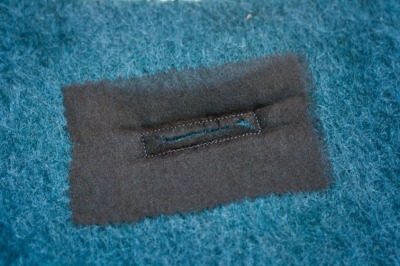 |
| 4 |
 |
| 5 |
 |
| 6 |
 |
| 7 |
 |
| 8 |
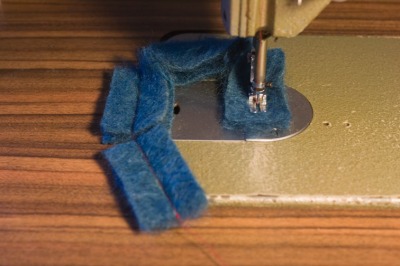 |
| 9 |
 |
| 10 |
 |
| 11 |
 |
| 12 |
 |
| 13 |
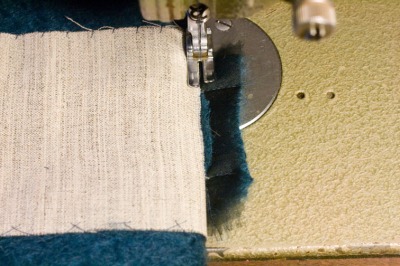 |
| 14 |
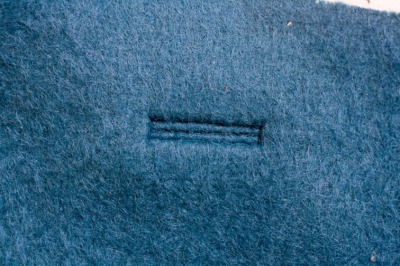 |
| 15 |
 |
| 16 |
 |
| 17 |
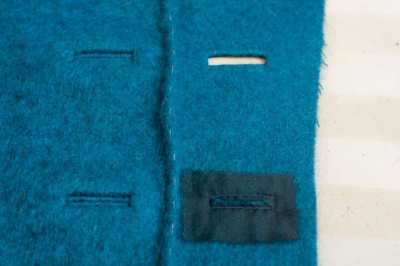 |
| 18 |
 |
| 19 |
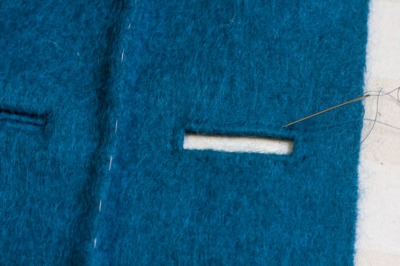 |
| 20 |
 |
| 21 |
As you can see, I’m doing lots of hand stitching on this jacket, just because I feel like doing so!
Now tell me, what is your favourite method for making bound buttonholes?























Great pictorial! I love how you handstitched around the facing “holes”. Will try that next time. It's very pretty.
Sometimes with a thick felted fabric I just use a strip of fabric as it does not ravel.Sometimes!
LikeLike
Wonderful photos! You've also made me realise that I made life far more difficult for myself than it needed to be when I made my Vogue coat at the end of last year. The lining was attached (though bottom left loose) BEFORE I started opening up the rear of the bound button holes. Idiot! I will be interested to read other techniques that readers suggest. (I used the Reader's Digest technique also.)
LikeLike
Wow, they are beautiful buttonholes! you are doing a superb job on this fabric.
LikeLike
This comment has been removed by the author.
LikeLike
Thanks Sherry. I think you're ready to sell video tutorials. I'd buy!
LikeLike
Gorgeous. Picture 9 made me laugh out loud – the welts looks like little sausages joined like that!
LikeLike
EPIC! I am super impressed by how much work has gone into this!!
LikeLike
Each time I see that fabric I love it more, its such a gorgeous colour!
My favourite method of bound buttonholes is the same way you normally do it (in your tutorials) – its the same as in my Tailoring book as well and I've found its the easiest way to get consistently good buttonholes (well they are good enough for me anyway, lol!)
LikeLike
Great pictures! I'm surprised at how much I understood what you were doing without and descriptions. Your bound buttonholes turned out great!
LikeLike
I like the look of the recessed buttonhole! (And fabric to die for!)
Brenda
LikeLike
Nicely done as usual:) I appreciate that you show others how much work is involved in creating a quality garment. It is well worth the time and effort and quite lovely to see that it is still valued….making my heart sing this morning….
LikeLike
These bound button holes look superb! Thank you for all the process pictures, it will definitely help me in the future, when I give it a go.
LikeLike
Wow, these buttonholes look great! Thanks for sharing.
LikeLike
For really thick fabrics, turning a 'window' with organza means that there is much less thickness to turn in the corners (as opposed to other methods where you sew the thick welts to the jacket itself). It's much easier to get a clean corner with this method in thick fabrics. Looks very good!
LikeLike
Thanks for sharing this with us – I'm about to start doing bound buttonholes on a thick wool coat. The approach looks a lot more practical than the method I was using!
LikeLike
Very pretty! It's fun looking at a tutorial on luscious fabric, too. I've never seen this technique before, and I like how the organza layer lines up with the welts so that you know how to attach them. And how it creates a clean box. I've tried a few different methods but mostly I've stuck with the one-piece way–I need some practice because I have a hard time sewing over those tiny triangles!
LikeLike
Your buttonholes look great! Once the buttonholes are completed, what is your method of making the facing to properly position everything?
Thank you
Marie
LikeLike
Those buttonholes look great – but I agree, that is not my method. I make them in the same way I make welt pockets, just tiny version, and I have never had a problem. Someone recently showed me that method and I thought it was really difficult to get them to match. Lovely color – that coat will look great on you.
LikeLike
Outstanding,Sherry! Get it bookmarked and printed.
Thanks,
Cennetta
LikeLike
Ok, so I am obviously not as seasoned and precise a stitcher as you, but when I was making my red Lady Grey jacket a year or two back, out of a very thick boiled wool, I tried out every bound-buttonhole technique I could find on samples, and this one was the only one I could get to look good reliably. I actually hand-stitched the welts in place, though, to get them properly positioned. They have held up fine. I think sometimes Reader's Digest Complete Guide recommends things because they're a little easier for those of us who aren't really stellar at the whole precision thing to get good results, not necessarily because it's the best technique out there. 🙂
LikeLike
Thanks for sharing! I have yet to learn how to do this, so i'll bookmark this!
Florencia
LikeLike
Buttonholes to aspire to! Just beautiful, and some very nice tips as well, thank you! 🙂
LikeLike
If anybody could make perfect bound buttonholes in this really tricky fabric, it is you Sherry! Magnificent work, as usual. 🙂 You are a master in this very difficult technique. Thank you so much for the very helpful pictures!
LikeLike
This tutorial is so clever! Thanks for sharing! Now I'd like to see this jacket in action! It looks so warm and cozy 🙂
LikeLike
Gor-jois! Time for you to make (and market) videos with your excellent and wonderfully illustrated techniques! I, for one (and there will be hordes of others), will buy. You're a naturally-born teacher. Thanks for another winning tute!
LikeLike
Thanks Bunny! I wasn't quite sure about the use of prickstitching here, but it's growing on me and it does a good job of taming the organza!
LikeLike
I remember your beautiful coat! The great thing is that you learnt from it, and won't do it that way again!
LikeLike
Ha ha, that's my factory method – saves time and thread!
LikeLike
Thanks for that Richard! You are right, the corners are very clean this way. I must try my usual method on the remnants and see what happens, of course I should have done some samples to start with…!
LikeLike
I remember you trying out buttonholes back then! That is what I should have done. And I never even thought of hand stitching them in place first – that would have really helped *head desk*!
I picked up RD recently secondhand and was impressed with the many different methods of bound buttonholes – I suppose it is a matter of finding the right one, ie sampling!
LikeLike
Thank you that was awesome!
LikeLike
The buttonholes looks great, and I love the fabric! It's going to be a gorgeous jacket!
I'm by no means an expert, but when considering the different types of bound buttonholes when I was making my super thick wool coat last year, I went for an even overall thickness rahter than superneat corners, meaning I used something very similar to the technique you used on your cape (as described in “Tailoring the perfect jacket”). Easier to press, and I like the overall look =)
Of course, which method's “best” is of course up to the fabric and the sewist's preference!
LikeLike
Odličaj tutorijal za paspuliranu rupicu. Sačuvaću ga.
LikeLike
Oh wow! so professional. I have yet to attempt these. But this tutorial is seriously bookmarked for future reference… thank you! 🙂
LikeLike
This is so beautiful.
Very interesting blog. Thanks for sharing such useful information here.
Hope to see such a informative post very soon.
LikeLike
Thank you so much for yet another wonderful tutorial.
Can you help with the link to your normal method of working bound buttonholes, as it says you need clearance…………….would love to take a look at it.
Happy Christmas and many thanks for your wonderful blog, I love the technical details.
LikeLike
Absolutely love all your blog postings about different methods for working bound buttonholes. Your instructions and pictures are so clear.
I wonder how it may be possible to print off and keep in my tips and techniques folder in my sewing room?
LikeLike